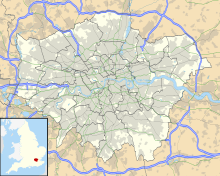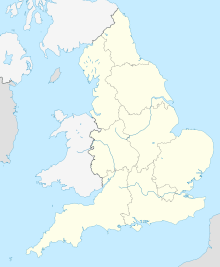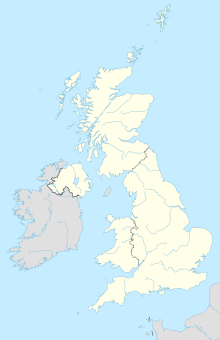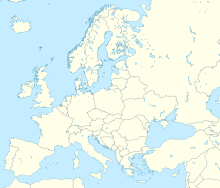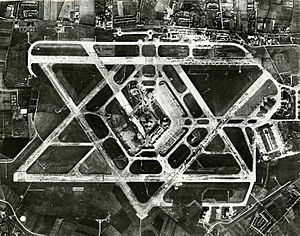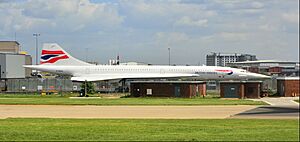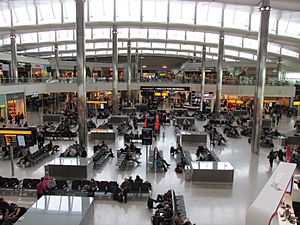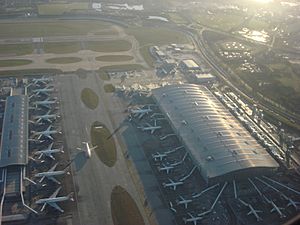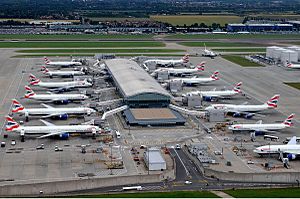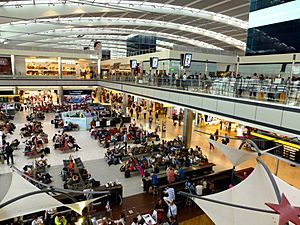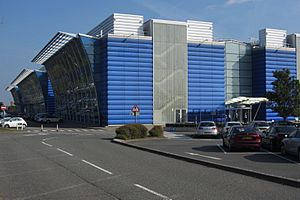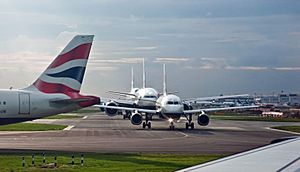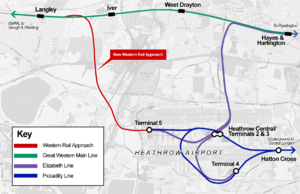Heathrow Airport facts for kids
Quick facts for kids
Heathrow Airport
|
|||||||||||||||
|---|---|---|---|---|---|---|---|---|---|---|---|---|---|---|---|
 |
|||||||||||||||
 |
|||||||||||||||
| Summary | |||||||||||||||
| Airport type | Public | ||||||||||||||
| Owner/Operator | Heathrow Airport Holdings | ||||||||||||||
| Serves | Greater London Urban Area | ||||||||||||||
| Location | Hillingdon, London, England | ||||||||||||||
| Opened | 25 March 1946 | ||||||||||||||
| Hub for | |||||||||||||||
| Built | 1929 | ||||||||||||||
| Elevation AMSL | 83 ft / 25 m | ||||||||||||||
| Coordinates | 51°28′39″N 000°27′41″W / 51.47750°N 0.46139°W | ||||||||||||||
| Map | |||||||||||||||
| Runway | |||||||||||||||
|
|||||||||||||||
| Statistics (2024) | |||||||||||||||
|
|||||||||||||||
|
Sources: CAA, Heathrow Airport Holdings
|
|||||||||||||||
Heathrow Airport (LHR) is a very important international airport in London, England. It is the biggest and busiest airport serving London. It is one of six major airports in the London airport system.
Heathrow Airport Holdings owns and runs the airport. In 2024, Heathrow was the busiest airport in Europe. It was also the fifth busiest airport in the world for passenger traffic. Heathrow had the most international flights of any airport in the world in 2024.
Heathrow started as a small airfield in 1930. It grew much larger after World War II. The airport is about 14 miles (23 km) west of Central London. It covers an area of 4.74 square miles (12.28 km²). Over 75 years, it expanded to have two parallel runways. It also has four passenger terminals and one cargo terminal. Heathrow is a main hub for British Airways and Virgin Atlantic.
Contents
Location and Surroundings
Heathrow Airport is located 14 miles (23 km) west of Central London. It is 3 miles (5 km) west of Hounslow. It is also 3 miles (5 km) south of Hayes. And it is 3 miles (5 km) north-east of Staines-upon-Thames.
The airport is entirely within the London Borough of Hillingdon. It has the postcode TW6. Villages like Sipson, Harlington, Harmondsworth, and Longford are to its north. Cranford and Hatton are to the east. To the south are Feltham, Bedfont, and Stanwell. The M25 motorway separates Heathrow from Slough, Horton, and Windsor in Berkshire.
Because the airport is west of London, planes often fly over the Greater London Urban Area when landing. This happens when the wind blows from the west.
History of Heathrow Airport
Heathrow Airport began in 1929. It was a small airfield called the Great West Aerodrome. It was located near a small village called Heathrow. The airport gets its name from this village. At that time, the area had farms and orchards.
Work to make Heathrow a bigger airport started in 1944. This was during World War II. It was meant for military planes flying to the Far East. But the war ended before it was finished. The UK government then decided to make it a civil airport.
The airport officially opened on March 25, 1946. It was first called London Airport. In September 1966, it was renamed Heathrow Airport. This was to avoid confusion with other London airports like Gatwick and Stansted. The main terminal area was designed by Sir Frederick Gibberd. He planned the terminals and central buildings, including the control tower.
Airport Operations
Airport Facilities
Heathrow Airport is used by over 89 airlines. These airlines fly to 214 places in 84 countries. It is the main hub for British Airways and Virgin Atlantic. The airport has four passenger terminals (numbered 2 to 5). It also has a special terminal for cargo. In 2021, Heathrow served 19.4 million passengers. The busiest year was 2019, with 80.9 million passengers. Heathrow is the UK's largest port by value. It connects to over 218 destinations worldwide. New York is the busiest single destination. Over three million passengers flew between Heathrow and JFK Airport in 2021.
In the 1950s, Heathrow had six runways. They were arranged like a star. Now, it has only two parallel runways that run east–west. These are longer versions of two of the original runways. From the air, you can still see parts of the old runways. They are now used as taxiways for planes.
North of the northern runway, there is an entrance to an access tunnel. This area also has a model of an Emirates Airbus A380. Before 2008, it was a model of a Concorde.
Heathrow Airport has chaplains from different religions. These include Anglican, Catholic, Free Church, Hindu, Jewish, Muslim, and Sikh. There is a multi-faith prayer room in each terminal. There is also a counseling room. St. George's Interdenominational Chapel is underground. Christian services are held there.
The airport has its own team of photographers and a TV crew. They work for major news outlets around the world.
Most internal roads at Heathrow are named with a letter. 'N' is for roads in the north, 'E' for east, 'S' for south, and 'W' for west. 'C' is for roads in the center.
Cargo Operations
Heathrow handles a lot of cargo. In 2022, it handled 1.4 million tonnes of cargo. The top places for cargo exports are the United States, China, and the United Arab Emirates. Popular items exported include books, salmon, and medicine.
Managing Flights
Planes flying to Heathrow usually go to one of four holding points. Air traffic controllers guide these planes to the airport. They combine planes from all four holding points into one line. Sometimes planes are as close as 2.5 nautical miles (4.6 km) apart. The airport uses special landing techniques to reduce noise. This is especially important at night. Once a plane is ready to land, Heathrow Tower takes over control.
To reduce noise, planes usually take off towards the west. They land from the east over London. This helps keep noise away from busy areas. Heathrow's two runways usually work separately. One runway is for landings, and the other is for takeoffs. To further reduce noise, the runways used for landing and takeoff are swapped at 3:00 PM each day if the wind is from the west.
Night flights at Heathrow have rules. Between 11:00 PM and 4:00 AM, the loudest planes cannot be scheduled. Also, from 11:30 PM to 6:00 AM, there are limits on the number of flights. There are also rules about how much total noise is allowed. Airlines have agreed not to schedule early morning arrivals before 4:30 AM.
In 2017, Heathrow started "Fly Quiet & Green." This is a list that ranks the 50 busiest airlines. It gives points based on how well they perform on environmental measures. This program was paused during the COVID-19 pandemic. It started again in October 2024 as "Fly Quieter & Greener."
During the COVID-19 pandemic, Heathrow saw many more cargo-only flights. Airlines used passenger planes to carry only cargo. Some cargo-only airlines also started flying to Heathrow.
Holding Stacks for Arrivals
Planes arriving at Heathrow follow specific routes. These routes end at one of four "stacks." Stacks are areas in the sky where planes fly in circles. They wait there if needed until they are cleared to land. You can imagine them as a spiral in the sky. Each stack goes down in 1,000-foot (300 m) steps. Planes hold between 7,000 and 15,000 feet (2,100 and 4,600 m). If these stacks get full, planes wait at points further away.
The four main stacks are:
- The Bovingdon stack: For planes coming from the northwest. It is above the village of Bovingdon.
- The Biggin Hill stack: For planes coming from the southeast. It is on the edge of Greater London.
- The Lambourne stack: For planes coming from the northeast. It is in Essex.
- The Ockham stack: For planes coming from the southwest. It is in Surrey.
Future Runway Plans
In September 2012, the British government created the Airports Commission. This group looked at ways to increase airport capacity in the UK. In July 2015, the commission suggested building a third runway at Heathrow. The government approved this idea in October 2016.
However, a court later said this plan was not allowed. This was because the government had not fully considered climate change and the environmental impact. But in December 2020, the UK Supreme Court allowed the third runway plan to go ahead. The plan slowed down due to the COVID-19 pandemic. However, after the Labour Party won the 2024 UK general election, the airport's CEO said he would seek a final decision from the government by the end of 2025.
Airport Rules and Fees
Heathrow Airport Holdings used to own Gatwick and Stansted airports. Because of its large size, the Civil Aviation Authority (CAA) closely regulates Heathrow. This means the CAA sets limits on how much Heathrow can charge airlines to land.
Until 2008, flights between Heathrow and the United States had strict rules. Only a few airlines could fly these routes. But a new "open skies" agreement started in 2008. This allowed more US airlines to fly to Heathrow. After Brexit, the US and UK signed a new agreement in November 2020. This agreement kept the "open skies" rules.
In 2007, Heathrow was criticized for being too crowded. Its facilities were designed for 55 million passengers a year. But in 2012, 70 million passengers used the airport. The opening of Terminal 5 in 2008 helped. It increased the airport's capacity to 90 million passengers per year.
Heathrow's two runways are used almost to their maximum. This means there is little room for more flights. It is hard for airlines to get new landing slots. To increase flights, Heathrow Airport Holdings has suggested using both runways for both takeoffs and landings. This could increase flights from 480,000 to 550,000 per year. They have also suggested building a third runway. This would greatly increase the number of flights.
Airport Security
The Metropolitan Police's aviation security unit is in charge of policing the airport. Sometimes, the British Army has also been deployed for security. Full body scanners are used at the airport. Passengers who do not use them must have a hand search in a private room. The scanners show passengers as cartoon figures. They show where hidden items might be.
After drone sightings caused problems at Gatwick Airport, Heathrow installed a drone-detection system. This helps stop illegal drone use.
Heathrow Terminals
Heathrow has four main passenger terminals.
Terminal 2: The Queen's Terminal
Terminal 2 is the airport's newest terminal. It is officially called the Queen's Terminal. It opened on June 4, 2014. It has 24 gates. The terminal was built where the old Terminal 2 and Queens Building used to be. It has a satellite pier (T2B) and a large car park. There are 52 shops and 17 restaurants.
Airlines moved into Terminal 2 over six months. This was done slowly to avoid problems seen when Terminal 5 opened. United Airlines was the first to move in June 2014. Many Star Alliance airlines use Terminal 2. It is also used for some UK domestic and Irish flights.
The original Terminal 2 opened in 1955. It was called the Europa Building. It was the airport's oldest terminal. It was designed for about 1.2 million passengers a year. But in its last years, it handled up to 8 million. Over its lifetime, 316 million passengers passed through it. The building was taken down in 2010.
Terminal 3: Long-Haul Flights
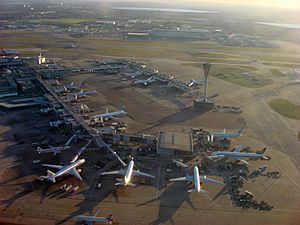
Terminal 3 opened on November 13, 1961. It was first called the Oceanic Terminal. It handled long-haul flights for foreign airlines to the United States and Asia. In 1968, it was renamed Terminal 3. It was expanded in 1970 with a new arrivals building. It also got the UK's first moving walkways. In 2006, a new Pier 6 was finished. This pier can handle the Airbus A380 superjumbo. Emirates and Qantas use Terminal 3 for their Airbus A380 flights.
The front area of Terminal 3 was updated in 2007. It got a new four-lane drop-off area. It also has a large walking area with a canopy. These changes made it better for passengers. They also helped reduce traffic and improve security. Virgin Atlantic got its own check-in area, called 'Zone A'.
As of 2013, Terminal 3 has an area of 98,962 square meters (1,065,220 sq ft). It has 28 gates. In 2011, it handled 19.8 million passengers. Most flights from Terminal 3 are long-haul flights. These are from North America, Asia, and other non-European countries. Many Oneworld and SkyTeam airlines use Terminal 3. British Airways also operates some flights from here.
Terminal 4: Global Connections
Terminal 4 opened in 1986. It has 22 gates. It is south of the southern runway, next to the cargo terminal. It connects to Terminals 2 and 3 by an underground tunnel. The terminal has an area of 105,481 square meters (1,135,390 sq ft). It is now home to the SkyTeam alliance. It also hosts several Oneworld carriers and other airlines.
Terminal 4 had a £200 million upgrade. This allowed it to handle 45 airlines. The front area was improved to reduce traffic and boost security. A new check-in area, renovated piers, and departure lounges were added. A new baggage system was installed. Four new stands were built for the Airbus A380. Qatar Airways uses Terminal 4 for its A380 flights. Most flights from Terminal 4 are to/from East Europe, Central Asia, North Africa, and the Middle East. Some flights to/from Europe also use it.
Terminal 5: British Airways Hub
Terminal 5 is at the western end of Heathrow. It is between the northern and southern runways. Queen Elizabeth II opened it on March 14, 2008. It opened to the public on March 27, 2008. It took 19 years to build. British Airways and Iberia use this terminal exclusively. It has 50 gates.
The first passenger entered Terminal 5 at 4:30 AM on opening day. He was given a boarding pass for the first flight to Paris. For two weeks after opening, there were problems with the terminal's computer systems. This led to over 500 cancelled flights.
Terminal 5 is used only by British Airways as its main hub. American Airlines moved to Terminal 5 in July 2020. This made it easier for passengers to connect between American and British Airways flights.
The terminal cost £4.3 billion to build. It has a main four-story building (Concourse A). It also has two satellite buildings. An underground train system connects them. Concourse A is for British Airways' smaller planes flying in the UK and Europe. Concourse B is for BA and Iberia's larger planes, except the Airbus A380. Concourse C has 7 stands for the A380. It became fully operational in June 2011. Terminal 5 was named the World's Best Airport Terminal in 2014.
The main terminal building (Concourse A) is 300,000 square meters (3,200,000 sq ft). Concourse B is 60,000 square meters (650,000 sq ft). It has 60 aircraft stands. It can handle 30 million passengers each year. It also has over 100 shops and restaurants. It is home to British Airways' special lounges.
A new building, Concourse D, might be built in the future. This would add more stands. This could be important after British Airways merged with Iberia.
The transport system around the airport was improved for Terminal 5. New train lines serve the Heathrow Terminal 5 station. A special motorway link connects the terminal to the M25. The terminal has a large multi-storey car park with 3,800 spaces. A driverless pod system, the Heathrow Pod, connects the terminal to a distant car park. This system started in spring 2011. An underground train system, the Transit, moves passengers between the main terminal and the satellite concourses.
Terminal Assignments
As of 2025, here's how Heathrow's terminals are used:
| Terminal | Airlines and alliances |
|---|---|
| Terminal 2 | Star Alliance, SkyTeam and several non-aligned airlines |
| Terminal 3 | Oneworld (except Iberia, Malaysia Airlines, Royal Air Maroc and Qatar Airways), British Airways (some destinations), Virgin Atlantic and several non-aligned airlines |
| Terminal 4 | SkyTeam (except Aeromėxico, China Airlines, Delta Air Lines, Middle East Airlines, Scandinavian Airlines and Virgin Atlantic) as well as most non-aligned airlines |
| Terminal 5 | British Airways (most destinations) and Iberia |
After Terminal 5 opened in 2008, airlines moved to new terminals. This helped group airlines by their alliances. When the new Terminal 2 opened in 2014, all Star Alliance airlines moved there. By June 2015, all airlines left Terminal 1. This was to make space for Terminal 2 to expand. Iberia moved to Terminal 5 on June 1, 2023.
Terminal Use During the COVID-19 Pandemic
Heathrow Airport has 115 gates. 66 gates can handle large planes. 24 gates can handle the Airbus A380. During the COVID-19 pandemic, Heathrow's services were greatly reduced. On April 6, 2020, the airport started using only one runway. Terminals 3 and 4 were temporarily closed. All remaining flights moved to Terminals 2 or 5. Both runways were used again in August 2020. But on November 9, 2020, Heathrow went back to single-runway operations. Terminal 4 was closed until the end of 2021. It was sometimes used for passengers from "red list" countries. Terminal 3 reopened on July 15, 2021. Terminal 4 reopened for normal operations on June 14, 2022.
Former Terminal 1
Terminal 1 opened in 1968. Queen Elizabeth II officially opened it in April 1969. It was the main base for British Airways' domestic and European flights. It also handled some long-haul routes before Terminal 5 opened. Terminal 1 was also the main base for most Star Alliance members.
Terminal 1 closed at the end of June 2015. The area is now being used to expand Terminal 2. Some newer gates from Terminal 1 were part of the Terminal 2 development. They are still being used. British Airways was the last airline to use Terminal 1. Two British Airways flights marked its closure on June 29, 2015. One flight left for Hanover, and one arrived from Baku. British Airways flights moved to Terminals 3 and 5. Since closing, Terminal 1 has been used for emergency services training.
Airlines and Destinations
Passenger Flights
The following airlines operate regular passenger flights at London Heathrow Airport:
| Airlines | Destinations |
|---|---|
| Aegean Airlines | Athens |
| Aer Lingus | Cork, Dublin, Knock, Shannon |
| Aeroméxico | Mexico City |
| Air Algérie | Algiers |
| Air Astana | Almaty |
| Air Canada | Calgary, Halifax, Montréal–Trudeau, Ottawa, Toronto–Pearson, Vancouver Seasonal: Mumbai (resumes 26 October 2025) |
| Air China | Beijing–Capital, Chengdu–Tianfu |
| Air France | Nice, Paris–Charles de Gaulle |
| Air India | Ahmedabad (resumes 2 August 2025), Bengaluru, Delhi, Mumbai |
| Air Peace | Abuja (begins 26 October 2025) |
| Air Serbia | Belgrade |
| All Nippon Airways | Tokyo–Haneda |
| American Airlines | Boston, Charlotte, Chicago–O'Hare, Dallas/Fort Worth, Los Angeles, Miami, New York–JFK, Philadelphia, Raleigh/Durham Seasonal: Phoenix–Sky Harbor |
| Asiana Airlines | Seoul–Incheon |
| Austrian Airlines | Vienna |
| Avianca | Bogotá |
| Azerbaijan Airlines | Baku |
| Beijing Capital Airlines | Qingdao |
| Biman Bangladesh Airlines | Dhaka, Sylhet |
| British Airways | Aberdeen, Abuja, Accra, Amman–Queen Alia, Amsterdam, Athens, Atlanta, Austin, Bahrain, Baltimore, Barbados, Barcelona, Basel/Mulhouse, Belfast–City, Bengaluru, Berlin, Bermuda, Billund, Bologna, Boston, Brussels, Bucharest–Otopeni, Budapest, Buenos Aires–Ezeiza, Cairo, Cape Town, Chennai, Chicago–O'Hare, Cincinnati, Cologne/Bonn, Copenhagen, Delhi, Denver, Doha, Dubai–International, Dublin, Düsseldorf, Edinburgh, Florence, Frankfurt, Geneva, Gibraltar, Glasgow, Gothenburg, Grand Cayman, Hamburg, Hanover, Hong Kong, Houston–Intercontinental, Hyderabad, Inverness, Istanbul, Istanbul–Sabiha Gökçen (ends 26 October 2025), Jeddah, Jersey, Johannesburg–O.R. Tambo, Kraków, Kuala Lumpur–International, Lagos, Larnaca, Las Vegas, Lisbon, Los Angeles, Luxembourg, Lyon, Madrid, Málaga, Malé, Manchester, Marrakesh, Marseille, Mexico City, Miami, Milan–Linate, Milan–Malpensa, Montréal–Trudeau, Mumbai, Munich, Nairobi–Jomo Kenyatta, Naples, Nashville, Nassau, New Orleans, New York–JFK, Newark, Newcastle upon Tyne, Nice, Oslo, Paris–Charles de Gaulle, Philadelphia, Phoenix–Sky Harbor, Pisa, Pittsburgh, Portland (OR), Prague, Providenciales, Reykjavík–Keflavík, Riga, Rio de Janeiro–Galeão, Riyadh, Rome–Fiumicino, San Diego, San Francisco, Santiago de Chile, São Paulo–Guarulhos, Seattle/Tacoma, Shanghai–Pudong, Singapore, Sofia, Stockholm–Arlanda, Stuttgart, Sydney, Tbilisi, Tel Aviv (resumes 26 October 2025), Tirana, Tokyo–Haneda, Toronto–Pearson, Toulouse, Valencia, Vancouver, Venice, Vienna, Warsaw–Chopin, Washington–Dulles, Zurich Seasonal: Abu Dhabi, Bodrum, Brindisi, Chania, Corfu, Dalaman, Dallas/Fort Worth, Dubrovnik, Faro, Figari, Heraklion, Ibiza, Innsbruck, İzmir, Kalamata, Kefalonia, Ljubljana, Mykonos, Nuremberg, Olbia, Palermo, Palma de Mallorca, Paphos, Perugia, Ponta Delgada, Preveza/Lefkada, Rhodes, Rimini, Salzburg, Santorini, Split, Thessaloniki, Tromsø, Zagreb, Zakynthos |
| Brussels Airlines | Brussels |
| Bulgaria Air | Sofia |
| Cathay Pacific | Hong Kong |
| China Airlines | Taipei–Taoyuan |
| China Eastern Airlines | Shanghai–Pudong |
| China Southern Airlines | Beijing–Daxing, Guangzhou, Wuhan |
| Croatia Airlines | Zagreb Seasonal: Split |
| Delta Air Lines | Atlanta, Boston, Detroit, Minneapolis/St. Paul, New York–JFK, Salt Lake City, Seattle/Tacoma |
| Egyptair | Cairo Seasonal: Luxor |
| El Al | Tel Aviv |
| Emirates | Dubai–International |
| Ethiopian Airlines | Addis Ababa |
| Etihad Airways | Abu Dhabi |
| Eurowings | Cologne/Bonn, Düsseldorf, Hamburg, Stuttgart |
| EVA Air | Bangkok–Suvarnabhumi, Taipei–Taoyuan |
| Finnair | Helsinki |
| Gulf Air | Bahrain |
| Hainan Airlines | Changsha, Haikou |
| Iberia | Madrid |
| Icelandair | Reykjavík–Keflavík |
| Japan Airlines | Tokyo–Haneda |
| JetBlue | Boston, New York–JFK |
| Kenya Airways | Nairobi–Jomo Kenyatta |
| KLM | Amsterdam |
| KM Malta Airlines | Malta |
| Korean Air | Seoul–Incheon |
| Kuwait Airways | Kuwait City |
| LATAM Brasil | São Paulo–Guarulhos |
| Loganair | Derry, Dundee, Isle of Man, Kirkwall, Sumburgh |
| LOT Polish Airlines | Warsaw–Chopin |
| Lufthansa | Frankfurt, Munich Seasonal: Salzburg |
| Malaysia Airlines | Kuala Lumpur–International |
| Middle East Airlines | Beirut |
| Oman Air | Muscat |
| Qantas | Perth, Singapore, Sydney |
| Qatar Airways | Doha |
| Royal Air Maroc | Casablanca |
| Royal Brunei Airlines | Bandar Seri Begawan, Dubai–International |
| Royal Jordanian | Amman–Queen Alia |
| RwandAir | Kigali |
| Saudia | Dammam (resumes 5 November 2025), Jeddah, Riyadh |
| Scandinavian Airlines | Copenhagen, Oslo, Stockholm–Arlanda Seasonal: Sälen-Trysil, Tromsø |
| Shenzhen Airlines | Shenzhen |
| Singapore Airlines | Singapore |
| SriLankan Airlines | Colombo–Bandaranaike |
| Swiss International Air Lines | Geneva, Zurich |
| TAP Air Portugal | Lisbon |
| Thai Airways International | Bangkok–Suvarnabhumi |
| Tianjin Airlines | Chongqing, Tianjin, Xi'an |
| Tunisair | Tunis |
| Turkish Airlines | Istanbul |
| United Airlines | Chicago–O'Hare, Denver, Houston–Intercontinental, Los Angeles, Newark, San Francisco, Washington–Dulles |
| Uzbekistan Airways | Tashkent |
| Vietnam Airlines | Hanoi, Ho Chi Minh City |
| Virgin Atlantic | Antigua, Atlanta, Barbados, Bengaluru, Boston, Cancún (begins 19 October 2025), Delhi, Grenada, Johannesburg–O.R. Tambo, Lagos, Las Vegas, Los Angeles, Miami, Montego Bay, Mumbai, New York–JFK, Orlando, Riyadh, San Francisco, Seattle/Tacoma, St. Vincent–Argyle, Seoul–Incheon (begins 29 March 2026), Tampa, Toronto–Pearson, Washington–Dulles Seasonal: Cape Town, Dubai–International, Malé |
| Vueling | Barcelona, Bilbao, Paris–Orly, Santiago de Compostela |
| WestJet | Calgary
|
Cargo Flights
| Airlines | Destinations |
|---|---|
| Aerotranscargo | Astana, Hong Kong |
| Cathay Cargo | Hong Kong, Paris–Charles de Gaulle |
| DHL Aviation | Amsterdam, Brussels, Cincinnati, Leipzig/Halle, Milan–Malpensa |
| Korean Air Cargo | Frankfurt, Paris–Charles de Gaulle, Seoul–Incheon |
| Lufthansa Cargo | Frankfurt |
| One Air | Jinan |
| Qatar Airways Cargo | Doha, Munich |
| Singapore Airlines Cargo | Amsterdam, Sharjah, Singapore |
| Virgin Atlantic | Seasonal: Brussels |
Airport Statistics
Overview of Traffic
Heathrow is the eighth busiest airport in the world for passenger traffic. It is behind airports like Hartsfield–Jackson Atlanta International Airport and Dubai International Airport. In 2019, Heathrow was named the best-connected airport globally. This means it had many connecting flights. British Airways handles 51% of flights at Heathrow.
In 2015, Heathrow was the busiest airport in Europe for passengers. It had 14% more passengers than Paris–Charles de Gaulle Airport. In 2013, it was the fourth busiest European airport for cargo.
In 2020, Heathrow's passenger numbers dropped a lot. They fell by over 72% due to the COVID-19 pandemic. This was a decrease of 58 million travelers compared to 2019. In March 2023, over four million passengers used Heathrow. It became the busiest airport in Europe again.
In November 2024, Heathrow Airport started testing Artificial Intelligence (AI). This system, called Amy, helps air controllers manage flights. It tracks planes using radar and video data.
Yearly Traffic Numbers
| Year | Passengers handled | Cargo | Aircraft movements | |||
|---|---|---|---|---|---|---|
| Numbers | % change | (tonnes) | % change | Numbers | % change | |
| 1986 | 31,675,779 | 537,131 | 315,753 | |||
| 1987 | 35,079,755 | 574,116 | 329,977 | |||
| 1988 | 37,840,503 | 642,147 | 351,592 | |||
| 1989 | 39,881,922 | 686,170 | 368,429 | |||
| 1990 | 42,950,512 | 695,347 | 390,372 | |||
| 1991 | 40,494,575 | 654,625 | 381,724 | |||
| 1992 | 45,242,591 | 754,770 | 406,481 | |||
| 1993 | 47,899,081 | 846,486 | 411,173 | |||
| 1994 | 51,713,366 | 962,738 | 424,557 | |||
| 1995 | 54,461,597 | 1,031,639 | 434,525 | |||
| 1996 | 56,049,706 | 1,040,486 | 440,343 | |||
| 1997 | 58,185,398 | 1,156,104 | 440,631 | |||
| 1998 | 60,683,988 | 1,208,893 | 451,382 | |||
| 1999 | 62,268,292 | 1,265,495 | 458,300 | |||
| 2000 | 64,618,254 | 1,306,905 | 466,799 | |||
| 2001 | 60,764,924 | 1,180,306 | 463,567 | |||
| 2002 | 63,362,097 | 1,234,940 | 466,545 | |||
| 2003 | 63,495,367 | 1,223,439 | 463,650 | |||
| 2004 | 67,342,743 | 1,325,173 | 476,001 | |||
| 2005 | 67,913,153 | 1,305,686 | 477,887 | |||
| 2006 | 67,527,923 | 1,264,129 | 477,048 | |||
| 2007 | 68,066,028 | 1,310,987 | 481,476 | |||
| 2008 | 67,054,745 | 1,397,054 | 478,693 | |||
| 2009 | 66,036,957 | 1,277,650 | 466,393 | |||
| 2010 | 65,881,660 | 1,472,988 | 454,823 | |||
| 2011 | 69,433,230 | 1,484,351 | 480,906 | |||
| 2012 | 70,037,417 | 1,464,390 | 475,176 | |||
| 2013 | 72,367,054 | 1,422,939 | 471,936 | |||
| 2014 | 73,374,825 | 1,498,906 | 472,802 | |||
| 2015 | 74,959,058 | 1,496,551 | 473,087 | |||
| 2016 | 75,676,223 | 1,541,029 | 473,231 | |||
| 2017 | 77,988,752 | 1,698,455 | 474,033 | |||
| 2018 | 80,102,017 | 1,788,815 | 477,604 | |||
| 2019 | 80,884,310 | 1,587,451 | 475,861 | |||
| 2020 | 22,109,723 | 1,150,030 | 200,905 | |||
| 2021 | 19,393,145 | 1,402,913 | 190,032 | |||
| 2022 | 61,611,838 | 1,350,878 | 384,383 | |||
| 2023 | 79,151,723 | 1,387,060 | 454,089 | |||
| 2024 | 83,859,729 | 1,536,384 | 473,965 | |||
Busiest Routes from Heathrow
| Rank | Destination | Passengers | Change 2023 / 24 |
|---|---|---|---|
| 1 | 3,238,557 | ||
| 2 | 2,856,618 | ||
| 3 | 2,006,096 | ||
| 4 | 1,902,023 | ||
| 5 | 1,679,883 | ||
| 6 | 1,549,602 | ||
| 7 | 1,510,465 | ||
| 8 | 1,460,574 | ||
| 9 | 1,438,046 | ||
| 10 | 1,418,172 | ||
| 11 | 1,309,796 | ||
| 12 | 1,294,030 | ||
| 13 | 1,197,342 | ||
| 14 | 1,174,518 | ||
| 15 | 1,158,732 | ||
| 16 | 1,145,736 | ||
| 17 | 1,135,962 | ||
| 18 | 1,132,812 | ||
| 19 | 1,128,059 | ||
| 20 | 1,104,336 | ||
| Source: CAA Statistics | |||
| Rank | Destination | Passengers | Change 2023 / 24 |
|---|---|---|---|
| 1 | 1,147,536 | ||
| 2 | 953,371 | ||
| 3 | 629,227 | ||
| 4 | 585,479 | ||
| 5 | 569,470 | ||
| 6 | 497,469 | ||
| 7 | 334,885 | ||
| 8 | 160,215 | ||
| 9 | 46,770 | ||
| 10 | 33,797 | ||
| Source: CAA Statistics | |||
Other Facilities at Heathrow
The main office of Heathrow Airport Holdings is in the Compass Centre. This building is near Heathrow's northern runway. It used to be a flight crew center for British Airways. The World Business Centre Heathrow has three buildings. One of them holds offices for Heathrow Airport Holdings and Scandinavian Airlines.
The British Airways head office used to be at Speedbird House within Heathrow. It moved to Waterside in Harmondsworth in June 1998.
North of the airport is the Northern Perimeter Road. Most car rental companies are located along this road. Bath Road runs next to it, outside the airport.
Getting To and From Heathrow
Public Transport Options

Train Services
There are three train services to Central London:
- Heathrow Express: This train goes straight to London Paddington. It leaves every 15 minutes. The journey takes 15 minutes (21 minutes from Terminal 5). Trains leave from Heathrow Terminal 5 station or Heathrow Central station (Terminals 2 & 3). There is a free transfer between Terminal 4 and Heathrow Central.
- Elizabeth line: This train stops at several stations. It goes to Abbey Wood and Shenfield through Paddington and central London. There are 6 trains per hour. Two start from Terminal 5, and four start from Terminal 4. It stops at Hayes & Harlington for connections to Reading. The trip to Central London takes about 35 minutes.
- London Underground (Piccadilly line): Four Tube stations serve the airport. These are Terminal 2 & 3, Terminal 4, and Terminal 5. Hatton Cross serves the maintenance areas. A trip from Heathrow Central to Central London usually takes 40–50 minutes.
Bus and Coach Services
Many bus and coach services operate from Heathrow Central bus station. This station serves Terminal 2 and Terminal 3. Buses also leave from the bus stations at Terminal 4 and Terminal 5.
Moving Between Terminals
Terminals 2 and 3 are close enough to walk between them. You can transfer from Terminals 2 and 3 to Terminals 4 and 5 using the Elizabeth line, Heathrow Express trains, or the London Underground Piccadilly line. A free bus service (route H30) connects Terminals 4 and 5 directly.
Passengers who stay within the airport (airside) can use free transfer buses. These buses use special tunnels to avoid disturbing aircraft.
The Heathrow Pod is a driverless transport system. It takes passengers between Terminal 5 and the business car park. These small pods run on demand on a four-kilometer track. Each pod can carry up to four adults, two children, and their luggage. There are plans to extend this system.
An underground train system called the Transit operates within Terminal 5. It connects the main terminal to the satellite Terminals 5B and 5C. This train system is entirely airside.
Hotel Access
Some hotels are directly connected to the terminals. You can walk to them without needing a transfer. Many more hotels are easy to reach using local buses. These buses leave from all terminals. The Hotel Hoppa bus network also connects all terminals to major hotels nearby.
Taxi Services
Taxis are available at all terminals.
Car Access
You can reach Heathrow by car using the nearby M4 motorway or A4 road (for Terminals 2–3). The M25 motorway (for Terminals 4 and 5) and the A30 road (for Terminal 4) also provide access. There are areas for dropping off and picking up passengers at all terminals. There are also short- and long-stay car parks. All Heathrow forecourts are for drop-off only. Other car parks are located just outside the airport. These are connected to the terminals by shuttle buses.
Four tunnels go under the northern runway. They connect the M4 Heathrow spur and the A4 road to Terminals 2–3. Two larger tunnels are for cars. The two smaller tunnels were for pedestrians and bicycles. Now, the cycle lanes have been changed to allow one lane of cars. Bicycles still have priority. Pedestrian access to the smaller tunnels has stopped. Free bus services are used instead.
Bicycle Access
There are bicycle routes, mostly off-road, to some terminals. Free bicycle parking is available at car parks 1 and 1A. It is also available at Terminal 4 and near Terminal 5's Interchange Plaza. Cycling is not allowed through the main tunnel to reach the central area and Terminals 2 and 3.
Incidents and Safety Measures
Airports, like any large transport hub, have had incidents. Heathrow has learned from these events to improve safety.
- On March 3, 1948, a Sabena Douglas DC-3 crashed in fog. 22 people died.
- On October 31, 1950, a BEA Vickers Viking crashed after hitting the runway. 28 people died.
- On January 16, 1955, a BEA Vickers Viscount crashed when its nose wheel broke. No one was hurt.
- On June 22, 1955, a BOAC de Havilland Dove crashed during a filming flight. No one was hurt.
- On October 1, 1956, an Avro Vulcan bomber crashed during bad weather. The pilot and co-pilot survived, but four others died.
- On January 7, 1960, a Vickers Viscount of BEA was badly damaged when its nose wheel collapsed. No one was hurt.
- On October 27, 1965, a BEA Vickers Vanguard crashed while landing in poor visibility. All 36 people on board died.
- On April 8, 1968, BOAC Flight 712, a Boeing 707, had an engine fire after takeoff. The plane landed safely, but five people died in the fire. A flight attendant, Barbara Harrison, was honored for helping people escape.
- On July 3, 1968, an Airspeed Ambassador plane crashed into two parked planes. Six crew members died, along with eight horses on board.
- On June 18, 1972, British European Airways Flight 548 crashed shortly after takeoff. All 118 people on board died.
- On November 5, 1997, Virgin Atlantic Flight 024, an Airbus A340, landed without its front landing gear. Two crew and five passengers had minor injuries. The plane was repaired.
- On January 17, 2008, British Airways Flight 38, a Boeing 777, crash-landed short of the runway. 18 people had minor injuries. The plane was too damaged to be used again.
- On September 28, 2022, a Korean Air Boeing 777 collided with an Icelandair Boeing 757. No one was hurt, but both planes had minor damage.
- On April 6, 2024, the wing of an empty Virgin Atlantic Boeing 787 hit a parked British Airways plane. No one was hurt, but both planes were damaged.
Security Incidents
Heathrow has also faced security challenges.
- On September 6, 1970, there was an attempted hijack of El Al Flight 219. The plane made an emergency landing at Heathrow.
- On May 19, 1974, bombs were placed in the Terminal 1 car park. Two people were injured.
- In March 1994, Heathrow was targeted three times by the IRA. They fired mortars, causing disruptions.
- In February 2003, the British Army and police were deployed. This was due to reports of possible missile attacks on planes.
- On February 25, 2008, Greenpeace activists protested against a third runway. They climbed on a British Airways plane. Four people were arrested.
- On July 13, 2015, thirteen activists from Plane Stupid broke into the airport. They chained themselves to the northern runway. This disrupted many flights. All were arrested.
- In June 2022, protesters gathered at Heathrow and Gatwick. They were protesting a plan to send asylum seekers to Rwanda. A flight for this purpose was cancelled.
- In December 2022, a small piece of uranium metal was found at the airport. This led to a counter-terrorism investigation.
Other Incidents
- On December 18, 2010, heavy snowfall closed the entire airport. This caused major problems. About 4,000 flights were cancelled. 9,500 passengers spent the night at Heathrow. The issues were due to snow and ice on runways and parking stands.
- On July 12, 2013, a fire started on an Ethiopian Airlines Boeing 787 Dreamliner parked at Heathrow. There were no passengers or injuries.
- From September 12, 2019, a group called Heathrow Pause tried to disrupt flights. They flew drones near the airport. This action did not stop flights, and 19 people were arrested.
Future Plans for Heathrow
Runway and Terminal Growth
Heathrow has a long history of plans to expand. After a public inquiry from 1995–99, Terminal 5 was approved. In 2003, a government paper suggested a third runway at Heathrow. In January 2009, the government supported building a third 2,200-meter (7,200 ft) runway and a sixth terminal. This was a debated decision due to concerns about pollution and noise.
Before the 2010 general election, the Conservative and Liberal Democrat parties said they would stop the third runway. The Mayor of London, Boris Johnson, wanted a completely new airport in the Thames Estuary. After the election, the third runway plan was cancelled. However, some politicians later changed their minds.
Another idea for Heathrow was the Heathrow Hub. This plan aimed to extend both runways to about 7,000 meters (23,000 ft). They would be divided into four parts. This would allow more takeoffs and landings at the same time. It would also reduce noise.
In July 2013, the airport sent three new expansion ideas to the Airports Commission. This group was looking at airport capacity in southeast England. Each idea involved building a third runway. It would be to the north, northwest, or southwest of the airport.
The commission's report in December 2013 listed three options. These were a third runway at Heathrow (north-west), extending an existing Heathrow runway, or a second runway at Gatwick Airport. The full report in July 2015 supported a third, north-west runway at Heathrow. Many people, including London Mayor Boris Johnson, did not like this report.
On October 25, 2016, the government confirmed Heathrow could build a third runway. A final decision was expected in late 2017/early 2018. The earliest it could open was 2025. On June 5, 2018, the UK Cabinet approved the third runway. On June 25, 2018, the House of Commons voted in favor of it. Local councils and environmental groups launched a legal challenge.
In February 2020, a court ruled the third runway plans were illegal. This was because they did not consider climate change commitments. However, the Supreme Court overturned this ruling in December 2020. The plan slowed down due to the COVID-19 pandemic. But after the 2024 UK general election, the airport's CEO said he would seek a "final" decision from the government by the end of 2025.
New Transport Ideas
Currently, all train lines to Heathrow go east–west to central London. There have been many ideas for new train links to other parts of London and beyond. The Elizabeth Line has already extended this service.
A plan in 2009 for a southern link to London Waterloo was stopped in 2011. This was due to a lack of money and problems with many level crossings. A plan to link Heathrow to the new High Speed 2 (HS2) railway line was also dropped in March 2015.
Other ideas being considered include:
- The Western Rail Approach to Heathrow: This would connect Heathrow to Reading, Slough, and other regions.
- Heathrow Southern Railway: This plan would connect Terminal 5 to places like Chertsey, Staines, and London Waterloo.
|
See also
 In Spanish: Aeropuerto de Londres-Heathrow para niños
In Spanish: Aeropuerto de Londres-Heathrow para niños
- Airports of London
- Heathrow Worldwide Distribution Centre
- List of airports in the United Kingdom and the British Crown Dependencies


